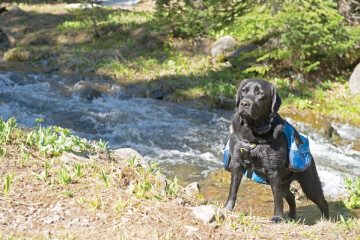Love at First Bite
A Quick Guide to Canine Cuisine

When my Labrador, Emma, turned two, it was time to switch her from her prescription diet to a “normal” one. As with any dog, food is a key factor in Emma’s health. Today, dog diets are as varied as people’s: choosing the “right one” can be a daunting task.
But, which of the 100s of options is best? If kibble, what brand? Grain free? Commercial raw? Raw? Limited ingredient? Home-cooked? Prescription diet? I recently sat down with a few of Bozeman’s experts to find some answers.
The Raw Diet
Nancy Tanner, Certified Professional Dog Trainer (CPDT) and owner of Paws and People, began feeding her dogs a raw diet 12 years ago, and remains a strong advocate of it.
Dogs are predators and opportunistic scavengers; based on their teeth, their diet should include food that necessitates tearing, ripping, and crunching. The raw diet stimulates these natural behaviors, Tanner explains, and results in improved health as well.
According to Tanner, a raw diet should include 50-60% muscle meat (alternating among chicken, turkey, lamb, beef, pork, Atlantic salmon, rabbit, or goat), 30-35% meat with crushed bone or whole bone, 10-15% organ meats from varied carcass sources, and 5-10% plant matter (such as dark leafy greens, yams, pumpkins, and blueberries).
Bones are imperative in a raw diet, Tanner explains, but to only give low-density, uncooked bones such as chicken wings, whole Cornish game hens, or lamb trotters. Dense bones, such as the femur, can cause fractures of the teeth. Cooked bones can shard like glass and be dangerous.
Interested in trying raw? Tanner suggests beginning with a commercially made raw diet while you learn about how to transition to your own. When she began feeding raw to her own dogs 12 years ago, little information or products were available. “The cool thing about today is that you can go into all three good stores in town [Dee-O-Gee, Bridger Animal Nutrition] and purchase commercially-made raw diets that have been very well thought out and put together,” she said.
Good nutrition is particularly important to Tanner because of the work she does with her clients. “Working with training behavior, nutrition is super important to me. No matter how much someone wants their dog to sit nicely when being petted, if you’re feeding a poor quality, nutritionally deficient diet, the dog can’t do it,” she explained.
If you decide to try a raw diet, she emphasizes the importance of monitoring your dog’s health. Can you lightly feel the rib cage and hip pointers? Does the dog have good muscle mass? Is it active? Coat shiny? Eyes bright?
Kibble
Feed stores can be overwhelming with scores of choices. How to decide? Holly Allen, the founder (with husband Josh) of Bozeman’s Dee-O-Gee stores, takes each dog’s particular issues and health status into consideration, including activity level, allergies, and personal preference of the owner, before suggesting different food options. “For us, background is always what kind of dog you have, if you’ve had any allergy testing done, and what are those allergens. Sensitive dogs are always a little different because most people don’t have any testing done on them, so it becomes trial and error.”
She suggests beginning with a limited ingredient, grain free food, with a single protein and carbohydrate source, and to consider supplements. “Most dogs can benefit from digestive enzymes,” she said. Most kibble foods are cooked at high temperatures and digestive enzymes don’t make it through processing, so adding them to a diet that is exclusively kibble is important.
Tanner’s philosophy on kibble mirrors Allen’s: choose a high-end product with meat as the first ingredient. Corn, soy, and wheat are not digestible but serve as good fillers. Tanner says “look for a meat-source protein in the first five ingredients and little to no grain because a dog can’t use it anyway and more dogs are allergic to grain than not.”
Allen is also an advocate of raw diet but feels that the high-end kibble (with added supplementation) is just fine. “The food that we truly wish and believe all dogs would eat would be a raw diet. It’s optimum for their body function at its peak. Also, the raw diet is about 95% protein … dogs are designed to eat meat.”
Allen also emphasizes the importance of providing a variety of proteins on a rotational basis (with raw or kibble): “There’s research showing that if you keep a dog on the same food they could eventually develop an allergy to it. Also, there are different nutrients and enzymes coming from different foods. My perspective is that combining different things creates an optimum working level for them. Typically, their immune system will be more at its peak, and things just work a little better.”
What about grain free? “I think for some dogs it’s fine,” Allen maintains. “There’re two perspectives: grain free is wonderful because typically you’re going to get more protein, more meat, and that’s ideally what we want for our dog. For allergy dogs and sensitive stomach dogs, a lot of times eliminating the grain can help solve the issue, but I do think there are some dogs whose digestive tract, for whatever reason, is not handling the higher protein content and healthy whole grains (such as brown rice, millet, oatmeal, or steel cut oats) help make them a little more regular. Sometimes the grain free trend can be a little tricky.”
In short, Allen suggests the owner do explore all options before settling in on one food. “I would definitely encourage people to check out other avenues, and do some research. Food choice really boils down to the health of the dog.”
A Veterinarian Weighs In
What about puppies? Dr. Dawn McDonald of 360 Pet Medical considers the breed and the size of the dog. “We steer people who have large breed dogs towards large breed food because scientifically, calorically, ingredient wise, those help them grow at a slow, steady pace, which is important because the faster a large breed dog grows, the more joint issues it can have.”
Transitioning to a new food should be done gradually—McDonald recommends over 7-14 days. She suggests feeding twice daily, but there are exceptions. Puppies should be fed three times a day until they are four months old or reach a certain weight. Large breed, deep-chested dogs should be fed smaller meals more often to avoid issues with gastric bloat. Can dogs be free-fed? Only if a dog is normally thin and a grazer, she clarifies. “A lot depends on the dog, but as a general default either free feeder that’s not overweight, or twice a day tends to cover most dogs.”
McDonald supports a raw diet when done properly. She says, “It is much easier to do a commercially-prepared raw diet and there are enough companies doing a good job that you can be more sure that your dog is getting a complete and balanced diet. The problem when you go off commercial and you try and do it yourself is more than likely that your dog is going to be deficient.
“Anyone who wants to do raw, I encourage them to have their veterinarian involved,” McDonald reiterates.
Prescription diets are something else McDonald will recommend for some dogs with specific health problems.
Regarding grain free, McDonald feels “certain dogs shouldn’t be on grain free if it is one of the formulas that rely more on protein and fat, and those would be kidney and pancreatitis patients. Also, some hunting dogs seem to need a little bit of added fiber. So if a dog that is on a grain free food continues to have diarrhea, let your veterinarian know because it may be that particular dog food does not have the kind of fiber that particular dog needs.”
In conclusion, “Just recognize that not every diet is right for every dog, and not every diet has to cost an arm and a leg. Look at what your budget is and just strive to do the best you can,” McDonald adds.
So What’s the Right Diet?
There really isn’t one. As with humans, dogs that are provided poor quality nutrition tend to experience compromised health. Owners should research the best choice for their dog—including consulting with a veterinarian—but it really comes down to what our dog is telling us: Does the dog exhibit good muscle mass and a glossy coat?
Maintain proper body weight? Have shiny, strong teeth? Pass normal stool? Maintain a normal activity level based on normal daily routines?
A dog that looks and acts healthy is probably eating well. Just keep in mind: it’s up to you to make sure your companion is getting what he or she needs nutritionally. Spending time doing research and speaking with some experts can help guide you towards what’s ultimately best for your pup.
Missy Seu is a freelance writer specializing in pet-related topics. She also works with her husband, Phil, in their pet photography business (Canine Pixel Pet Photography) here in Bozeman. She can be reached through her website www.cerebralcanine.com.


